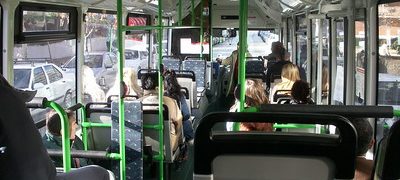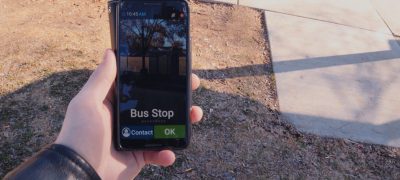
Hello Everyone,
N-CATT enjoyed a particularly productive summer with lots of technical assistance activities as we virtually spent time all over the country, opening up zoom Strike Team meetings and State Technology Summits in California, Indiana, Maine, Minnesota, Mississippi, New Mexico, New York, and South Carolina. Be sure to read below about the state summits. Our white papers are nearing completion and other resources are in the pipeline as we continue to serve tribal, rural, and small urban transit systems.
Please feel free to let us know about your technology questions and how we can guide you. Above all else, please be careful out there as we continue to deal with the pandemic. We hope that everyone remains healthy.
Enjoy the cooler weather and stay well,
Sheryl Gross-Glaser
Editor, N-CATT Tech News
Director, National Center for Applied Transit Technology
Community Transportation Association of America
grossglaser@ctaa.org
202.386.1669
N-CATT Webinars
Upcoming Webinars
Autonomous Vehicle Pilots and Beyond
Sep. 16, 2020
This webinar will discuss where we are in the U.S. now in the development and deployment of AVs and we will provide information regarding various aspects of AVs, such as technology deployment, user acceptance; safety, social and economic aspects, and regulations, policies, and legal issues. Further, this webinar will briefly describe the work conducted by the US Department of Transportation’s (USDOT’s) Federal Transit Administration (FTA) in AVs. Given the current COVID-19 situation, the webinar will briefly cover the impact of the virus on AV operation. Click here to register.
Transit Technology Promising Practices
Oct. 15, 2020
This webinar will tie together promising practices for successful technology adoption and case studies that examine a range of technologies from maintenance operations to fare payment to software interoperability. We will discuss ways to ensure that small urban, tribal, and rural transit agencies make sound technology decisions that add value to their operations for years to come. Click here to register.
Visit the N-CATT Events page for information about our webinars.
Featured Archived Webinars
Transit agencies are moving towards zero-emissions transportation technology with the goals of improving public health through the elimination of tailpipe emissions and providing a better experience for passengers. Two N-CATT webinars provide real-world advice and examples of how to shift toward electric vehicles and accompanying infrastructure.
Electric Vehicles for Transit
Aired on Aug. 4, 2020
This webinar summarized practical information about deploying electric vehicles, discusses charging technology, and infrastructure, and partnerships with electric utilities and other stakeholders to lay the foundation for successfully introducing and transitioning over to electric vehicles. For rural transit agencies considering fleet electrification, a strong relationship with their electric utility is critical. A transit agency with zero-emission vehicles (ZEVs) will become one of their utility’s largest customers. Learn how to work successfully with your utility to make smart decisions about fleet electrification that will optimize operational costs and help you achieve your goals.
Hydrogen Fuel Cell
Aired Aug. 18, 2020
This webinar covered the “other electric bus:” hydrogen fuel cell electric vehicles. This technology offers flexibility to deal with the deployment challenges that a rural community can face while maintaining the benefits of zero-emission transportation. Speakers from technology companies and transit agencies explained the particulars of the technology including implementation, user experience and community benefits.
Opportunities
N-CATT RFP for Additional Resources
N-CATT has issued requests for proposals (RFPs) to develop guidebooks and white papers to be published on the N-CATT website. Topics include: Connected Vehicles, Data Practices, Clean Energy Adoption, Software Adoption, Transit Website Strategies, and Public Engagement. Questions for each are due by Sep. 17, and answers will be posted on the RFP webpage. Final proposals for each solicitation are due Sep. 30. Reference the links on the webpage for full solicitations and details.
Inclusive Design Challenge
U.S. DOT opened the Inclusive Design Challenge, a competition seeking design solutions to make future automated vehicles more accessible to people with disabilities. They seek innovative design solutions that can enable people with physical, sensory, and cognitive disabilities to use automated vehicles to access jobs, healthcare, and other critical destinations. Proposals are due Oct. 30, 2020.
New FTA Events Page
For upcoming events of any FTA-funded technical assistance center and other relevant events for those audiences, the Federal Transit Administration is (FTA) is now hosting an Events webpage. Featured events currently include webinars, a safety workshop, and a technical assistance center roundtable discussion.
N-CATT State Summit Report
By Andrew Carpenter, Deputy Director of N-CATT
N-CATT staff spent July and August working with four state Departments of Transportation (DOTs) to host technology summits to identify their statewide priorities for future technology implementations, and to lay the foundation for the technology plans that will guide them forward in a rapidly changing landscape.
Though each state focused on its own priorities during its technology planning, they each took a slightly different tack based on the current state of technology adoption among their transit agencies and within the DOTs themselves:
- New Mexico identified items the DOT can do that will build support for small agencies across the state. This includes developing a buyer’s guide for how to navigate vendor language during the procurement process, and how to structure contracts to benefit transit agencies. In addition, the DOT will step up development of GTFS and GTFS-flex mapping across the state, while also forming a planning committee to tackle other themes covered during regional breakout sessions.
- Maine is concentrating on bolstering the technology that serves the concept of the “complete trip,” focusing on fare payment, scheduling and dispatch, and automated vehicle location as three prongs to scale across the state.
- Minnesota discussed the priorities that the rural and small-urban agencies want the state to focus on while developing the Greater Minnesota Technology Plan. The Tech Plan served as a baked-in next step following the summit for solidifying the details of the identified priorities.
- Mississippi has been developing a statewide technology plan in tandem with its six mobility regions. The summit reviewed the regions’ draft plans and provided strategies for the final drafts that will inform the DOT’s statewide technology plan.
Common Themes
Each DOT and its localities face unique challenges and are at different levels of technological implementation, yet many conversations coalesced around a common set of issues:
- Jurisdictional boundaries do not line up with passengers’ mobility needs. As a result, agencies expressed a desire to be able to coordinate their back offices’ demand-response software. This way, staff or software itself can assign passengers to the most appropriate vehicles and agencies based on seat availability, origin, and destination.
- Passengers need a one-stop shop for navigating transportation options. In conjunction with coordinated back office software, the states are interested in developing a passenger-facing portal that would allow travel anywhere within those states without having to navigate to multiple sources. This would encompass the range of one-call/one-click centers, mobile/web apps, and mobility management.
- Transit agencies were already exploring electronic and mobile fare payment systems, but the pandemic has accelerated this trend. The state DOTs and agencies involved in the technology summits are interested in exploring widespread deployment, including contactless payment options with pre-paying fares through passenger portals, and even a statewide fare system in Maine.
- Many of the state summit conversations turned to ways the state DOTs could support smaller agencies that do not have the capacity to research technology options, despite being interested in using them. As a result, the DOTs are exploring what they can pursue at the state level that localities will be able to opt into to fulfill their technological needs.
Of course, there are many challenges to address within those headline topics, but the energy in the state summit Zoom rooms demonstrated that momentum is building to confront these challenges head-on. The work has not ended with the state summits; rather this is a beginning. N-CATT will continue to meet with the state DOTs to help them flesh out their technology plans, and to advise about how to navigate the evolving world of transit tech.
Pivoting to Virtual Engagement
While the summits were originally supposed to take place in person, like almost all other events across the U.S., we pivoted to virtual meetings. And they worked out!
The new format taught N-CATT staff a lot about how to hold long-form, interactive meetings, and we will build on that for virtual summits if we must hold them online again in the future. It took a whole re-think about how to engage with a large group to hold a conversation and convey information while competing with Zoom fatigue and the day-to-day pressures that transit managers from small systems must face. We learned again some of the lessons of elementary school teaching to find ways to spur discussion and reduce Zoom time: We held small group work in separate meetings, gave breaks, called on participants to contribute thoughts, and tightened schedules.
We hope to be able to show up in person in the near future, but at least we know we can continue our important work online if need be.
Summit in a Box
Keep an eye out for a new N-CATT resource: State Summit in a Box. This resource tool will enable state DOTs on their own to convene agencies around their states to discuss their technological needs and plans in a flexible format.
Ridehailing Inequities for People with Disabilities: A Murky Area of the Law
An interesting court decision recently was issued from the Ninth Circuit Court of Appeals in Namisnak v. Uber Technologies, Inc., one of several ADA cases that have been brought against Uber. The court’s discussion makes plain that there will be no easy resolution of whether Uber and its ridehailing peers are violating the Americans with Disabilities Act (ADA). Worse yet for disability groups is the procedural labyrinth that awaits people with disabilities in challenging ridehailing companies.
The Ninth Circuit allows the case to proceed and rejects Uber’s motion to dismiss. The case is at a very early stage and its findings clarify how carefully disability organizations must proceed when deciding when and how to bring cases alleging discrimination against people with disabilities and violations of the ADA.
In summary: The case proceeds for those plaintiffs who did NOT download the Uber app. Downloading the app equaled agreement to arbitrate with Uber instead of being permitted to proceed in federal court. Those who did not download did not “agree” to the terms of service related to arbitration.
Not downloading or actually attempting to call for accessible service was okay in this case – the plaintiffs have standing – because there was absolutely no wheelchair accessible Uber service in their city. They therefore did not have to show that they tried to obtain an accessible ride and that the response was inadequate. The plaintiffs (who did not download the app) were not required to perform the “futile gesture” of attempting to obtain an accessible ride where one does not exist.
Critical Question for Court
The critical fact in the Namisnak decision was that Uber did not offer WAV – wheelchair accessible vehicle – service at all in New Orleans, where the plaintiffs reside. The Ninth Circuit distinguishes a Seventh Circuit case because WAV service did exist in Chicago. In the Chicago case, people with disabilities were therefore required to download the app and attempt to use Uber before filing a lawsuit.
In Federal Court, a State Rule Can Prevail
The Ninth Circuit’s Uber decision rests partly on state law, which is California law here, regarding whether downloading the app would be required for proceeding with the lawsuit. Because the court found that this is a state law issue, and analyzed appellate decisions discussing California state law, the result could be different in another state – even with exactly the same facts.
N-CATT Meows on Twitter
Find N-CATT meows at @TransitNCATT.
- @NJTRANSIT will begin testing electric buses in Camden to see how they perform, and whether they should be rolled out across the state.
- This #microtransit service has increased ridership throughout #COVID19. Read details to see how. Plus, this service is serving previously underserved communities. #transit
- A really interesting account of how a rural transit agency had to adapt in the face of the pandemic, but still find ways to serve the community.
- California is partnering with @BYDCompany to help transit agencies across the state purchase #ElectricBuses Zero-emission goals.
- Transport for New South Wales in Australia is trialing new tech to keep women safe on while traveling at night.
- @AVTA1 has agreed to start building a solar array which will be used to power their increasingly Electric, Zero-Emission vehicles.
- As part of their COVID response, buses in Orange County, CA will have real-time rider information available so riders will know how full any vehicle they want to ride.
N-CATT Transit Images
Before Technology Comes Grit
Crip Camp: A Disability Revolution, is a documentary about the disability civil rights movement that is informative and inspirational as it tells the story about what a determined group of people accomplished.
Barack and Michelle Obama serve as executive producers under their Higher Ground Productions banner.
The film begins with a summer sleepaway camp like many others that operated in the Northeast in the 1960s and 70s, except that this particular summer camp became a nurturing testing ground for an organized assemblage of people with disabilities across the U.S. With everything from ordinary teenage summer romances to sports, the campers gave to each other confidence and recognition that reverberated throughout their lives and led in no small way all the way to the passage of the Americans with Disabilities Act and to expansion of accessibility and respect for people with disabilities that continues today.
This documentary is available for free on YouTube; it is a full-length movie (1 hr., 46 min.). It is also available on Netflix.



